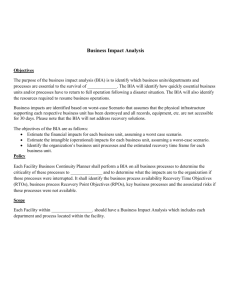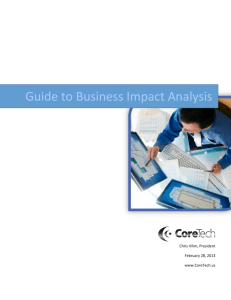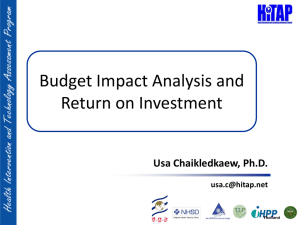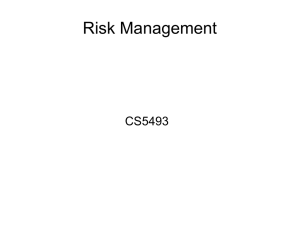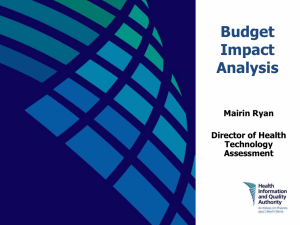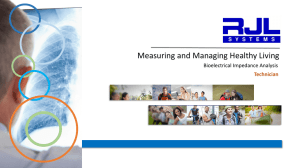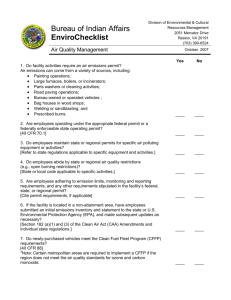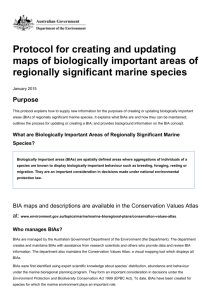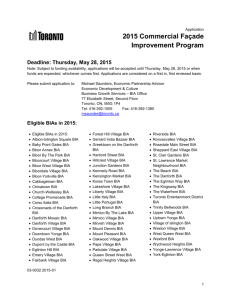How to Conduct a Hospital Business Impact Analysis
advertisement
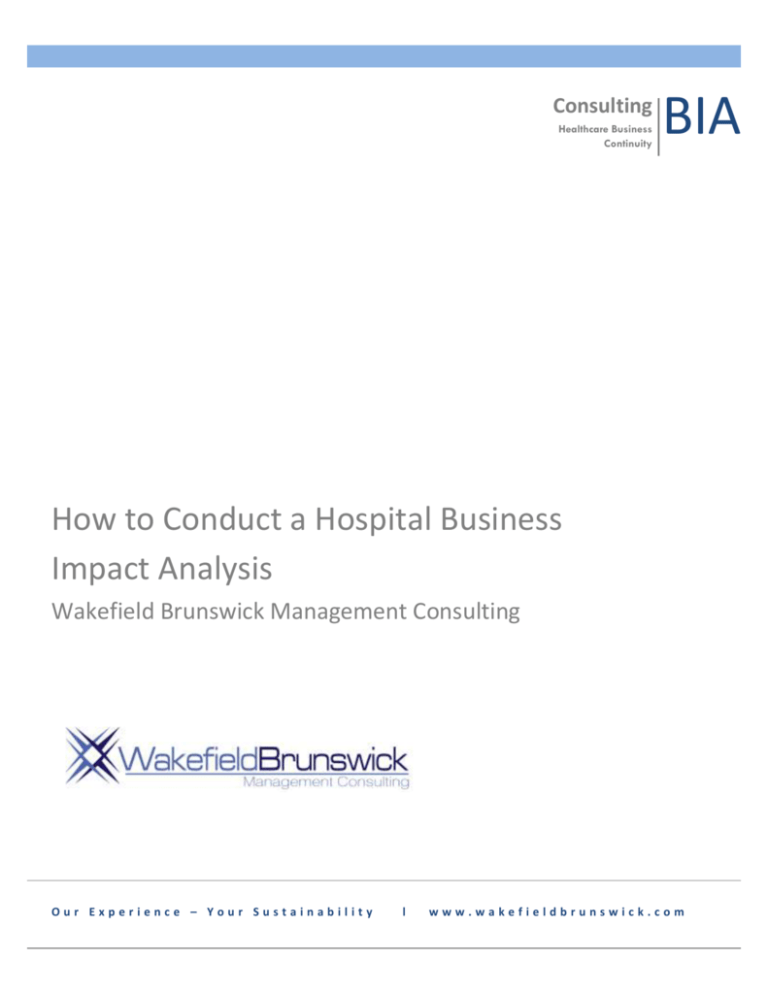
Consulting Healthcare Business Continuity BIA How to Conduct a Hospital Business Impact Analysis Wakefield Brunswick Management Consulting Our Experience – Your Sustainability l www.wakefieldbrunswick.com About Us Our focus is healthcare. We understand the delivery of healthcare services is complex yet essential to the strength and sustainability of our communities. As advisors, advocates, and facilitators, we assist healthcare organizations develop strategies to protect their vital resources, providing guidance in the development of their business continuity, disaster management, information technology and healthcare management programs. Learn more at www.wakefieldbrunswick.com. 2 METHODOLOGY The methodology used in conducting Business Impact Analyses (BIA’s) for our hospital clients follows international professional practices as defined by the Disaster Recovery Institute International1 however the process and questionnaires are tailored to specific objectives set by hospital priorities. GOVERNANCE AND PROJECT MANAGEMENT Governance ***Engage department directors and hospital leadership Scope Definition: Establish and meet with the steering committee and determine what it is they want to know as a result of the BIA and what decisions do they need to make. Executives are responsible for: Market share in a highly competitive healthcare environment Extensive regulations Profitability in a low margin industry Operational improvements Community and board relations Executives are liable for: 1 Interruptions to health services resulting in: Adverse impacts to patient safety and reputation among community and board members Loss of market share (patients go to alternate provider for care) and or/revenue Regulatory fines and corrective actions Adverse impacts resulting from: Security breaches and IT downtime The loss of business-critical information or patient health information Wakefield Brunswick co-led the development of the upcoming DRII Business Continuity for Healthcare Providers curriculum. 3 Project Management Identify BIA team: The key personnel to participate in and conduct the BIA. Finalize scope: The scope includes a sampling of sites, departments, and personnel from the Hospital, Business, and Research departments. Collect a list of all departments and associated cost centers from Finance. Departmental data is required initially to identify the list of departments needed to complete a BIA and provide necessary data for the financial calculations. Identify a source of record (phone list or HR database) for the contact information of the leaders of the departments identified as target BIA recipients. Design Reconciliation of and tracking of departmental data is a common challenge. Document in advance which fields of data are required and keep information in one master record (spreadsheet or database). The following fields are recommended: Division (ex: Nursing) Division Leader (ex: Vice President) Department (ex: Neonatal Intensive Care Unit) Department Leader (ex: Director) Note: Departments may have multiple department leaders and associated cost centers. E.g. An administrative director, a nursing director and/or medical director or chief. Contact information including e-mail and phone number for division and department leaders Columns for tracking and reporting on progress for the dashboard Dashboard Data Targeted Recipients Interviews Scheduled % Scheduled Interviews Completed % Completed BIA Tool Entry % Entered BIA Tool Reconciled % Completed 4 Finalize data gathering plan/data gathering tool. Develop initial Business Impact Analysis Questionnaire: The BIA questionnaire is designed to determine each department’s or unit’s essential functions and the top applications/systems that support those functions. In addition to the design of the question, to ensure consistency in both how the questions are asked and how the data is gathered, consider the following: o Ensure the number of employees reported is consistent (e.g., total headcount or full-time employees [FTE’s]) o Capture hours of operation so that employee cost and hourly revenue losses are more accurate. o Inquire if daily revenue is based on 365 days or a 5-day workweek. o Normalize data such as drop down menus for essential functions and impact ratings. o Consider creating a separate BIA for research and non-clinical departments that do not have patient impact or family experience impact scores to calculate. Establish a communications schedule. Conduct the Business Impact Analysis Interviews and Risk Assessment 5 Upon finalizing the schedule, send invitations each interviewee and their Vice President. Each interviewee receives the questions in advance. Deliver BIA team training: The “Train the Trainer” workshop includes an overview of BIA methodology, the facilitator’s instructions, guides, questions, and training for data entry. Conduct the interviews in a facilitated approach with a BIA analyst and recorder. While it is expected that the BIA analyst conducting the interview will have their individual style when asking questions, it is essential that questions are asked with the outcome in mind. For example, identify the 3 most essential functions first, then revisit each function and ask questions regarding the top 3 applications and their impact to each function. If an application, function, department, or name provided does not exist in the drop down menu, the recorder documents the information. Following the interview, validate that the information does not exist and follow change management procedures to add it to the source table. Once added, the recorder logs into the tool to complete the entry of the BIA for that department. Track everyone initially targeted in the master spreadsheet, as well as any BIA recipients that may be added for interviews. Additional recipients can be noted by documenting in the tracking spreadsheet the date that participant was added to the scope of the BIA. Validate initial responses with subject matter experts: Each interviewer and recorder reviewed their data entry and notes to ensure that each interviewee identified essential functions and correlating applications systems. This is an area at risk of being overlooked and can affect data integrity at the analysis phase if not complete. A recommended approach includes a team review of the interview, notes, and data entry. This allows for a review of interviewing techniques, how answers were interpreted, consistent depth of note taking, and a review of data entry Perform Risk Assessment: A risk/ threat assessment examines historical and likely future events that pose a hazard to the operations of the hospital and the IT infrastructure. Understanding what potential events allows the hospital to plan and to mitigate or eliminate the impacts of these events. Analysis The aggregated BIA data supports the verification of the application portfolio inventory while enhancing the content. The data is used to establish the Recovery Time Objectives (RTO) and Recovery Point Objectives (RPO) for each application. RTO defines the maximum duration of service or application outage before significant operational, patient care or family experience impacts occur. RPO addresses the maximum amount of tolerated data loss. These two metrics, combined together, establish application tiers for the prioritization and sequencing of application recovery. RTO and RPO also are used to influence technology used to meet requirements of replication and backups. S AMPLE A PPLICATION T IER D ESCRIPTION Tier Description RTO RPO Example 0 Foundational Infrastructure Email, Network, Phones 1 Critical 0-4 hr <30 min CIS, EPIC 2 Urgent 4-24 hr <60 min Lawson, ETM 3 Important 24-96 hr <12 hr CIS Training Application 4 Required 5-7 days 12-36 hr Archived Images To complete the Tier Assignments by RTO and RPO perform the following steps: 1. Run an export from BIA Tool into excel of all the records (if needed) 2. Conduct quality assurance on the data and/or conduct a gap analysis: Review each record for data integrity, missing metrics and complete reconciliation of any independent data sources. 3. Create a view of the data showing all impact scores assigned by the customer/user. 4. Assign values (weights) to each of the impact scores. 6 SAMPLE WEIGHT ASSIGNMENTS : IMPACT SCORES Description Weight Operations Impact N/A or blank >72 hours <72 hours <24 hours < 8 hours <4 hours 0 hours 0 1 3 5 7 9 11 Patient Safety Impact 9 - null (or blank) 1 - None at all 2 - minimal risk 3 - moderate risk 4 - severe risk 5 - immediately life threatening 0 1 3 5 7 14 Family Impact 9 - null (or blank) 1 - none at all 2 - minimal 3 - moderate 4 - severe 0 1 3 5 7 5. The weights are added together and multiplied by the enterprise context resulting in a total impact score. 6. The Total Impact Score is used to create preliminary application tier assignments. In the final Applications by Tier Report it is important to note applications are ultimately placed in tiers based on their Impact Score as well as other factors. For example, an application may have a Tier 2 score however it is a Tier 1 due to the fact it is a required dependency for another Tier 1 application. Financial Analysis The financial data gathered in the BIA allows us to measure the financial impact of individual or cumulative financial impacts of IS downtime. The data gathered to calculate this includes: # of department FTEs: # of department FTE’s for each cost center (this includes total FTE’s, not total number of employees. The number of employees may be higher as some employees are considered a 0.5 FTE) Average Daily Employee Cost: Average annual employee cost (Average Annual Employee Cost = Average Annual Employee Salary + Benefits). Productivity Loss (if 75% production loss, it is recorded as 0.75) 7 Daily Revenue Daily Financial Impact Calculation Report The final step is creating the report. A comprehensive report includes a narrative detailing both subjective and quantitative findings. Present findings to Project Sponsor and executives: The Project Sponsor will receive a draft report for review and editorial feedback. The final report is accompanied with a presentation to be delivered to the Executive team. 8 This document is the property of Wakefield Brunswick and is intended to be a supporting working document for participants attending the November 2, 2011 webinar titled, “How to Conduct a Hospital Business Impact Analysis”. It is not intended to be a complete and comprehensive program guide. Questions about this document, webinar or Wakefield Brunswick may be directed to adevlen@wakefieldbrunswick.com. 9
